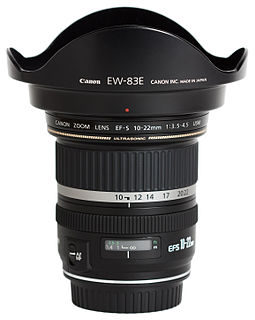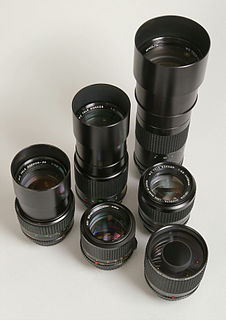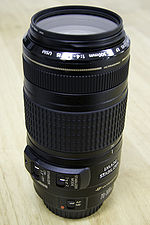
Introduced in 1987, the EF lens mount is the standard lens mount on the Canon EOS family of SLR film and digital cameras. EF stands for "Electro-Focus": automatic focusing on EF lenses is handled by a dedicated electric motor built into the lens. Mechanically, it is a bayonet-style mount, and all communication between camera and lens takes place through electrical contacts; there are no mechanical levers or plungers.

The Canon EF 24–70mm lens is a family of professional EF mount wide-to-normal zoom lenses manufactured and sold by Canon. The first of the family, the EF 24–70mm f/2.8L, was introduced in 2002 to replace the well-regarded 28–70mm f/2.8L. Two later versions were announced in 2012. The first of these, the EF 24–70mm f/2.8L II, was announced by Canon in February, but would not ship to customers until September of that year. This lens replaced the Mk I, and had an MSRP of US$2299 when introduced. The latest member of the family is the EF 24–70mm f/4L IS USM, which became available in January 2014. The f/4 version, which is the first of the family to include image stabilization, was initially reported to be the standard kit lens for the Canon EOS 6D, but did not appear in 6D kits in most markets until late 2014, and 5D Mark IV kit in 2016.

The EF 16–35 mm lens is a family of professional wide-angle lenses made by Canon Inc. The original version, the EF 16-35mm f/2.8L USM, replaced the EF 17-35mm f/2.8L USM lens, which had itself replaced the EF 20-35mm f/2.8L lens.

The EF 17–40mm f/4L USM lens is a wide-angle lens made by Canon Inc. The lens has an EF mount to work with the EOS line of cameras. Other than the front element, it is sealed against dust and water, and features a diaphragm which remains nearly circular from f/4 to f/8. It is one of the few Canon photo lenses that are parfocal.

The EF 50mm lenses are a group of normal prime lenses made by Canon that share the same focal length. These lenses are based on the classic double-Gauss lens, with the f/1.8 being a standard six-element double-Gauss with an air gap and powers between element 2 and 3 and its faster cousins adding additional elements. The 50mm focal length, when used with a 35mm film or full-frame sensor, has been widely considered to match the perspective seen by the human eye.
The Canon EF 28–105 mm f/4–5.6 is an inexpensive zoom lens often included as a kit lens with Canon 35 mm single-lens reflex cameras. 28–105 mm is a standard wide to telephoto zoom range. The Canon EF 28–105 mm f/3.5–4.5 USM is a higher quality zoom lens with a better build quality. Currently every version of this lens is discontinued. Some versions of the lens may include the word macro or a flower icon which indicates macro capability, however due to the 1:5.2 image magnification ratio it cannot be considered as a true macro lens.

The Canon EF-S 17–85mm f/4–5.6 IS USM is a standard zoom lens for Canon digital single-lens reflex cameras with an EF-S lens mount and image stabilization. The EF-S designation means it can only be used on EOS cameras with an APS-C sensor released after 2003. The field of view has a 35 mm equivalent focal length of 27.2–136mm, and it is roughly equivalent to the Canon EF 28-135mm lens on a 35mm film SLR. Despite the word "macro" being present on the lens body, this lens is not capable of true 1:1 macro photography.

The Canon EF-S 10–22mm f/3.5–4.5 USM lens is a wide to ultra-wide angle zoom lens for Canon digital single-lens reflex cameras with a Canon EF-S lens mount. The field of view has a 35 mm equivalent focal length of 16–35mm, which is analogous to the EF 16–35mm f/2.8L on a full-frame camera. The 10–22mm is an internal focusing lens. Of the 13 elements, one is of Canon's Super Ultra-Low Dispersion glass and three are aspherical elements.

The EF 85mm lenses are a group of medium telephoto prime lenses made by Canon Inc. that share the same focal length. These lenses have an EF type mount that fits the Canon EOS line of cameras.
The EF 24–105mm f/4L IS USM is an EF mount wide-to-telephoto zoom lens. It was introduced by Canon in 2005 to complement the well-regarded 17–40mm f/4L USM and 70–200mm f/4L USM.
The EF 100–400 mm f/4.5–5.6L IS USM is a professional EF mount telephoto zoom lens manufactured by Canon Inc. The first version of this lens was announced in September 1998, and an updated version was announced in November 2014. It is a high performance telephoto lens most often used for sports and wildlife photography.

The Canon EF-S 17–55mm f/2.8 IS USM is a standard zoom lens for Canon digital single-lens reflex cameras with an EF-S lens mount. The field of view has a 35 mm equivalent focal length of 27–88mm.
The EF 200mm USM lens is an L-series prime telephoto lens made by Canon Inc. for the EOS line of cameras. Four 200mm primes were made: f/1.8, two f/2.8, and the most recent f/2.0.

Introduced in 1995, the Canon EF 75–300mm f/4–5.6 lens is a telephoto zoom lens for Canon EOS single-lens reflex cameras with an EF lens mount. There are 3 basic types of the lens: the IS USM, the USM and non-USM. All 3 types are generally considered to be low-end consumer-level lenses.

The Canon EF-S 18–200mm lens is a superzoom lens, manufactured by Canon. It is the higher end kit lens for the Canon EOS 60D digital camera, and supplants the previous EF-S 17–85mm, in Canon's product line-up, losing 1mm off the wide end, and offering a roughly 2.5x longer telephoto end.
The Canon EF-S 18–135mm lens is a standard to short telephoto telezoom for Canon digital single-lens reflex cameras with an EF-S lens mount. The field of view has a 35 mm equivalent focal length of 29–216mm. With its 7.5× zoom range, it is placed into the superzoom category. Canon offers further lenses with even higher zoom ranges, such as the EF-S 18–200mm lens.

The EF 35–350mm f/3.5–5.6L USM lens is a discontinued telephoto zoom lens manufactured by Canon.
The EF 200–400mm f/4L IS USM Extender 1.4× is a EF mount super telephoto zoom lens produced by Canon. It is part of the professional L-series and functions with the Canon EOS line of cameras. The EF 200–400mm lens features an ultrasonic motor, image stabilization and weather sealing. It is the first and only EF lens with a built-in extender.





















